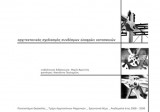Wood as one of the first building materials saw the inauguration of the first building systems, such as arches, trusses and frames. The first joints were tenons and halving joints made by carpenters but afterwards nails gave an alternative solution in joining.
The industrial Revolution signaled the use of iron in loadbearing components such as beams and columns. The production of new types of metal joints contributes tothe development of loadbearing structures and joints.
The standardization of size of loadbearing sections wasakey point in the evolution of their use. Steel replace iron giving birth to high-rise buildings and long span buildings.The suspended system that was used in constructing bridges maximizing their long span had as a result the evolution of the pin joint.
During the 20th century the design process associated with the process production.
The leaders of modernism attempt to bring the style of industrial production into architectural design. Their morphological forms are characterized for their simple geometry and the simplicity of the structural elements.
The architects that design custom elements in corporation with scientific groups, design structural forms which were characterized for their innovational morphology.
Either through simplicity or through complexity of the form, both architectural groups produce the same characteristics, transparency and lightness.
At both circumstances , the structural system used in the morphology of the building. However, the aesthetic of their building was completely different.
Through comparative studying of existed buildings came out with the conclusion that the design process of the form of a building is completely related to the structural base. As a result the type of the joint requires the study of the design parameters.
